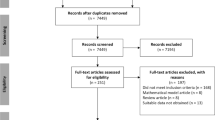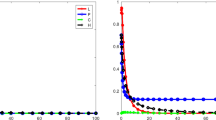Summary
Three mechanisms by which increasing predation can increase prey population density are discussed: (1) Additional predation on species which have negative effects on the prey; (2) Predation on consumer species whose relationship with their own prey is characterized by a unimodal prey isocline; (3) Predation on species which adaptively balance predation risk and food intake while foraging. Possible reasons are discussed for the rarity of positive effects in previous predator-manipulation studies; these include the short-term nature of experiments, the large magnitudes of predator density manipulation, and various sources of bias in choice of system and interpretation of results.
Similar content being viewed by others
References
Abrams, P. A. (1982) Functional responses of optimal foragers.Am. Nat. 120, 382–90.
Abrams, P. A. (1984) Foraging time optimization and interactions in food webs.Am. Nat. 124, 80–96.
Abrams, P. A. (1987) On classifying interactions between species.Oecologia 73, 272–81.
Abrams, P. A. (1989) Decreasing functional responses as a result of adaptive consumer behaviour.Evol. Ecol. 3, 95–114.
Abrams, P. A. (1990) The effects of adaptive behavior on the type-2 functional response.Ecology 71, 877–85.
Abrams, P. A. (1991) The relationship between food availability and foraging effort: effects of life history and time-scale.Ecology 72, 1242–52.
Bianchi, T. S., Jones, C. G. and Shachak, M. (1989) Positive feedback of consumer population density on resource supply.TREE 4, 234–8.
Brown, J. H., Davidson, D. W., Munger, J. C. and Inouye, R. S. (1986) Experimental community ecology: the desert granivore system. InCommunity Ecology. (J Diamond and T. J. Case, eds), pp. 41–62. Harper and Row, New York.
Connell, J. H. (1975) Some mechanisms producing structure in natural communities: a model and evidence from field experiments.Ecology and Evolution of Communities. (M. L. Cody and J. M. Diamond, eds), pp. 460–90. Belknap Press, Cambridge, Massachusetts, USA.
Gilinsky, E. (1984) The role of fish predation and spatial heterogeneity in determining benthic community structure.Ecology 65, 455–68.
Gilpin, M. E. (1975)Group Selection in Predator-Prey Communities. Princeton University Press, Princeton, N.J., USA.
Godin, J. G-J. (1990) Diet selection under the risk of predation.Behavioral Mechanisms of Food Selection. (R. N. Hughes, ed.), pp. 739–70. Springer Verlag, Berlin.
Hassell, M. P. (1978)The Dynamics of Arthropod Predator-Prey Systems. Princeton University Press, Princeton, N.J., USA.
Levine, S. (1976) Competitive interactions in ecosystems.Am. Nat. 110, 903–10.
Lima, S. L. and Dill, L. M. (1990) Behavioural decisions made under the risk of predation: a review and prospectus.Can. J. Zool. 68, 619–40.
May, R. M. (1973)Stability and Complexity in Model Ecosystems. Princeton University Press, Princeton, N.J., USA.
Paine, R. T. (1966) Food web complexity and species diversity.Am. Nat. 100, 65–75.
Pimm, S. (1982)Food Webs. Chapman & Hall, New York.
Rosenzweig, M. L. (1971) Paradox of enrichment: destabilization of exploitation ecosystems in ecological time.Science 171, 385–7.
Rosenzweig, M. L. (1973) Evolution of the predator isocline.Evolution 27, 84–94.
Sih, A., Crowley, P., McPeek, M., Petranka, J. and Strohmeier, K. (1985) Predation, competition, and prey communities: a review of field experiments.Ann. Rev. Ecol. Syst. 16, 269–311.
Taylor, R. (1984)Predation. Chapman & Hall, New York.
Turner, A. M. and Mittelbach, G. G. (1990) Predator avoidance and community structure: interactions among piscivores, planktivores, and plankton.Ecology 71, 2241–54.
Yodzis, P. (1989)An Introduction to Theoretical Ecology. Harper and Row, New York.
Author information
Authors and Affiliations
Rights and permissions
About this article
Cite this article
Abrams, P.A. Why don't predators have positive effects on prey populations?. Evol Ecol 6, 449–457 (1992). https://doi.org/10.1007/BF02270691
Issue Date:
DOI: https://doi.org/10.1007/BF02270691




